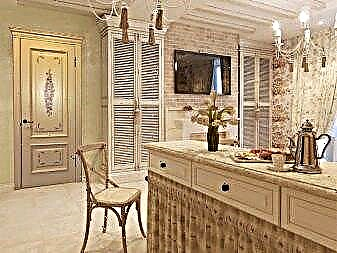The benefits of finishing include:
- harmony with any style
- a huge range of textures, shapes and colors,
- originality,
- easy care and long life,
- wall decoration in this way is not difficult,
- the stone is not prone to infection by fungal formations,
- environmental friendliness
- light weight.
Cons of artificial stone:
- shorter service life relative to natural material,
- some samples made from soft material quickly take a shabby appearance,
If you correctly select this decorative element, the listed disadvantages will remain in the shade. To protect against negative environmental influences, its surface is treated with special impregnation or varnished.
Combining Artificial Stone with Wallpaper
Decorative stone is unique in every way, and any type of wallpaper will be in harmony with it. So that they serve for a long time, you should choose high-quality paintings. Liquid wallpaper is great for the hallway.
You can also use paper, non-woven or glass.
Paper material is cheap, it is easy to glue on walls, it lends itself well to painting.
Non-woven wallpaper has a porous structure, it is easy to hide any irregularities and cracks under them. They also have strength, withstand paint well.
Cullets are favorably combined with a decorative stone, as it has a relief surface.
Photowall-paper will look not bad. It is important that they match the selected stone as closely as possible.
Color schemes
Most often, in the modern design of the hallway they use beige, gray or brown shades.
To visually increase the space, light shades are used that imitate marble, granite, quartz or pebbles.
It is better to choose light wallpapers for dark stone finishes.
The best option would be if the wallpaper is taken two shades lighter than stone.
Various bright colors are also relevant.
Styles
The entrance hall creates the first impression of the home, and therefore it is very important for her to choose the design. Consider the design options, where they use the duet "stone + wallpaper".
Modern style. Chooses a white stone for a brick and light wallpaper.
Eco style. Shale rocks are used here.
Urbanism. Uses brick tiles.
Classic. Decorates the walls with marble or granite.
Country and Provence. Use gray, brown stone of various shapes. Combined with ordinary wallpaper, murals and murals.
It’s not uncommon to add “street lamps” to such an interior.
Interesting ideas
So, let's see what can be done to unusually beat the walls with a decorative stone with wallpaper in the hallway?
- Apply uneven edges to make the walls look voluminous.
- Install spotlights to highlight lining.
- Add various decorations to the wall. Mirrors, paintings, fakes and compositions will be used.
- In the classical direction, put a stone on the columns, emphasizing the general surroundings.
- Hang shelves for storing little things.
Artificial stone on the arch
A popular option for using stone in the interior of the hallway is to stone the passage to different rooms. By connecting imagination, you can choose the best option for yourself.
The finish of the opening looks exclusive if the brick in some places goes to the wall.
The arch can be made in any color and style.
You can stone one side of the aisle.
Or stone it around.
Benefits
To name the reasons why stone decorating in the hallway is becoming popular is very simple. Here are just a few of them:
- Finishing stone is a great addition to any modern hallway.
- It goes well with other decorative elements.
- For decoration, you do not need to align the surface of the wall.
- Not afraid of moisture, resistant to wear, does not deform and does not crumble.
- It has antibacterial and dirt-repellent properties.

- Creates a feeling of calm and reliability.
- Do not lose relevance in the design of the interior.
- As detergents, you can use any detergents.
- Artificial decorative stone is lightweight, so there is no need to further strengthen the walls during the repair. For natural stone, it is necessary to increase the adhesion.
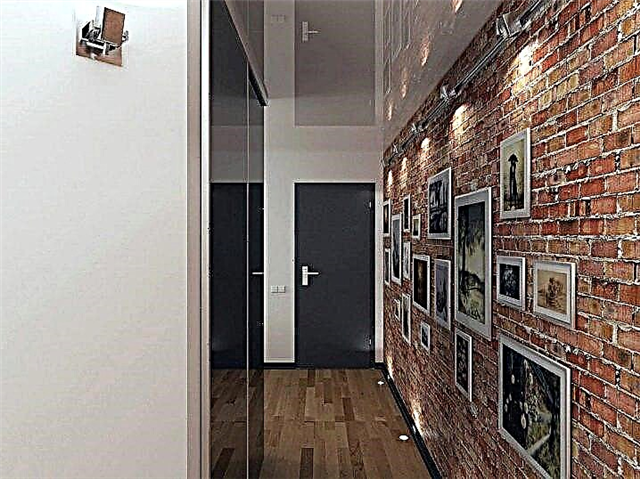
- Durability - the surface is not deformed or damaged. The service life with proper care will be about 15 years. If you wish, you can change the color of the walls and stone several times.
- Protects the surface of walls from mold and mildew.
- It has fire-resistant properties, does not burn and does not melt.
- Fast and not laborious installation.
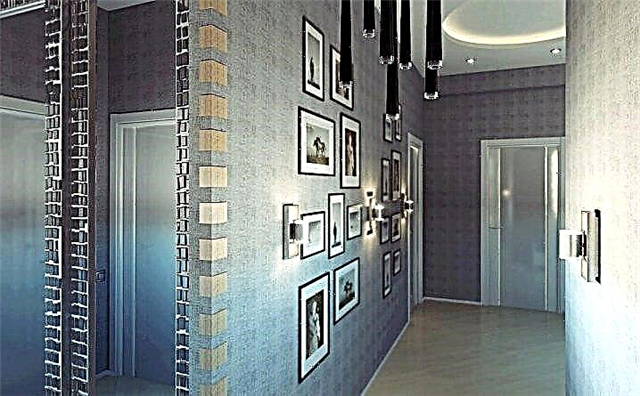
The disadvantages of this type of decoration include the high price of materials, but still, the type of stones and styling options affect the total cost.
Types of stones
When designing an apartment and a house, I want to use natural materials, but this is not always justified, especially when it comes to decorative stone decoration. Of course, the words “natural” or “natural” sound nicer and more attractive than “artificial”. However, do not succumb to outdated stereotypes that are not relevant at the present stage of production development. Wild natural stone is very expensive, and the design with its use requires high qualification and experience.

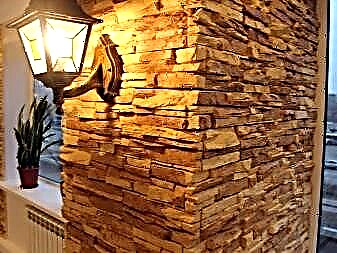


In the production process, artificial stone can take any shape, thickness, structure and color, while at first glance it is not so easy to distinguish natural stone from artificial stone. The main advantages of artificial stone are as follows:
- Light weight
- A wide range of operating temperatures allows the use of artificial finishing material for the design of fireplaces,
- It does not fade in the sun, which allows it to be used for exterior decoration of a building,
- Unpretentious in care and cleaning,
- Strong and durable, with proper installation and quality care, it will last about 15 years.




Material
No matter how strange it sounds, an artificial decorative stone is made on the basis of natural components. The main materials in the production are the following:

Cement stone has high strength and is not afraid of moisture. It can be washed with a stiff brush, or with liquid products. Such tiles can be used not only in the hallway and in other residential premises (living room, bath or kitchen), but also for exterior decoration of the house. Cement tile is also heavy. Compared to other types, it is more than 2 times heavier, therefore, to decorate a room with such a stone, it is necessary to additionally strengthen the walls.
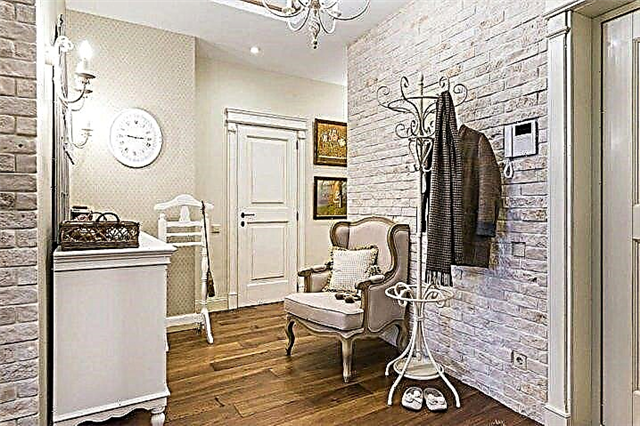
In addition, finishing materials from cement is difficult to cut, for this it is necessary to have a grinder and have some working skills. the high price of cement tiles is offset by a long service life and reliability. With proper care, such stones will retain their original appearance for a long time.
The agglomerate is based on natural crushed stones: granite, quartzite and marble. The rock crushed to the state of fine crumb is combined with cement and with polymer resins. Some types of decorative tiles are additionally stained with a coloring pigment. This tile has interspersed natural fragments and a smooth glossy surface.




Flexible decorative stone is made from sandstone. The hard rock is cut as thin as possible and ground to a smooth surface.After that, the sandstone slice is glued to the textile. Due to this production method, the natural pattern, texture and unique flexible design are preserved.

Using clay, we obtain clinker tiles, which are very similar to bricks. It is produced using the same technology: clay is burned in a furnace and passes glazing. Clinker tiles are no more than 3 cm thick. This material is often used to create loft or high-tech interiors.

Gypsum stone has similar characteristics: affordable price, low weight and the possibility of mounting on a wall made of drywall. But such types of decorative materials are afraid of moisture and may be destroyed during wetting. Therefore, after installing gypsum or clinker tiles, it is necessary to cover the surface with acrylic varnish or protective impregnation.

Colors
Decorative artificial stone can have different colors. In the production process, a coloring pigment is used, which is added to the solution, which makes the tile have a uniform uniform color on the entire surface. The next stage of production is the coloring of the front surface in the same color scheme with tinting agents, thus achieving a stone similar to the natural color. With this two-stage method of staining, even during damage or cleavage of the stone, the colors will not differ.
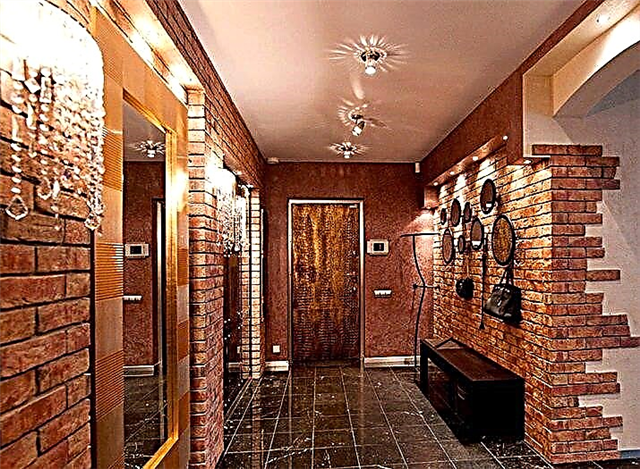
In the second method of staining, paint is applied only to the outside of the stone. In this case, the inner and outer parts of the tile have different colors.
- Decorative white stone can be painted independently during the repair process. So, any tile can have a natural natural light shade or can be treated with special construction paint. Also, the white color looks great in any room.
- Black stone It looks mysterious and attractive. It can be used with contrasting or plain dark colors.
- Saturated red the stone goes well with dark and bright elements in the corridor.
- Beige and brown - Similar to natural shades suitable for almost any style.
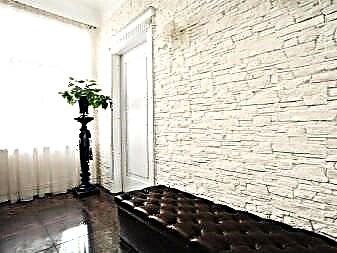


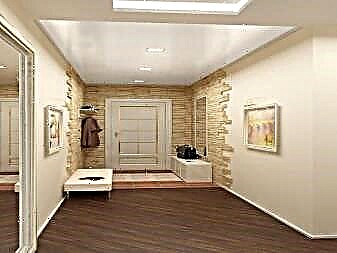
Mosaic stone is great for decorative decoration in the hallway. In this case, elements of different colors and shapes are used.
The form
In shape, decorative stones are no different from natural ones:
- Brick. The most popular, imitate various methods of laying ordinary brick,
- Rubble. They have a natural color and are similar in shape to pebbles or boulders,
- Tiled. They have a clear square or rectangular shape with chips and scratches on the external polished surface, outwardly similar to natural marble or granite,
- Chipped. They have a uniform color and resemble an untreated rock,


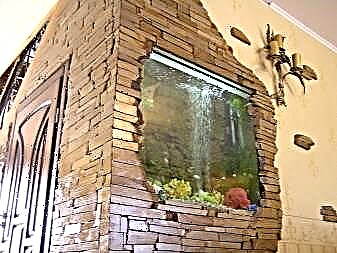
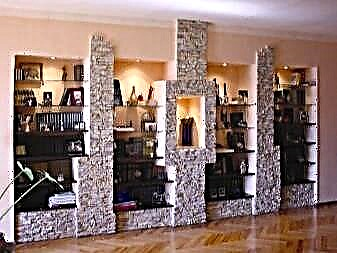
- Mosaic. Such tiles are adjusted to a certain shade or shape, after completion of installation work with such material the wall looks very unusual,
- Sawn. It has a clear rectangular shape, the front part of the stone does not undergo additional processing and has a rough surface,
- Fantasy. They have a complex shape and structure, the colors do not look like natural shades of nature, used for unusual stylistic design of the wall.
Types of premises
Designers say that the entrance hall plays a special role in the apartment, because this is the first room, as if meeting guests. Due to its properties, the stone is most suitable for decorating the corridor, because it is in the entrance part of the apartment that the most dirt and dust accumulates, and it is the entrance hall that requires careful and frequent cleaning. You can give it a stylish look or create the effect of an old room.

Decoration with stone can go well with decorative plaster, wood, ordinary wallpaper, tile, stucco or glass. It is considered an excellent backdrop for living plants and metal products.
When designing a small hallway, it is important to know the measure and not go too far with the finishing materials. For a stone decor, it is better to abandon the combination of different types of materials, and opt for one optionotherwise, you risk making the design too colorful and overload the room. For one hallway, the combination of two types of decorative fragments is considered optimal. At the same time, materials can have one color, but differ in texture.




Artificial stone has excellent thermal insulation properties and can be mounted on a "cold" wall. You can also make an unobtrusive transition from the corridor to the kitchen. A style combination will make the overall interior of the apartment softer and more holistic.

Design options
To decorate the hallway, it is not necessary to cover all the walls with stone. Such a finish can be a waste of money. A more rational solution would be the creation and placement of emphasis on individual sections of the corridor. The fragmentary decoration of the wall near the door, mirror or furniture looks very nice. Partial cladding has a stylish look, with its help you can arrange the following interior elements:
- Doorways near doors and windows. To do this, it’s better to use large stones in shape,
- Arched openings. In this case, a flexible stone is perfect,
- Contact areas and areas that are used to store clothes and shoes
- Troughs and niches
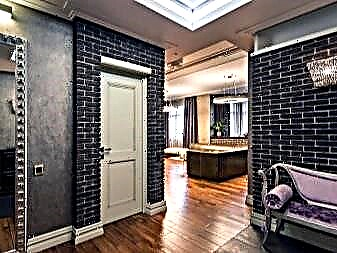
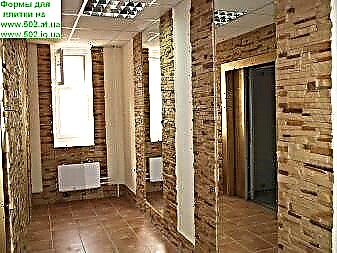


- Land at the corners. You can smooth the sharpness of the corners using a flexible stone,
- Mirrors
- Furniture items or a stone fireplace decorated look very appropriate and concise in any interior. With all this, the frame can have clear lines and geometric shapes with color transitions or laid out randomly.
The stone can be used to decorate many modern styles: loft, hi-tech, eco or minimalism. For a natural eco style, it is important to be able to combine natural elements with living plants. you can place pots with green plants on the floor along the stone wall, this will add lightness and airiness to the interior.
It is worth noting that the stone can also be used in the classical style, while you will be as if in a castle. The main thing that is necessary with such a design is a large space. If your hallway is spacious enough, you can safely choose a light brick tile as a finish for an entire wall. In any case, a large mirror in a stone frame looks very aristocratic and stylish. In addition, decoration with decorative stone walls is possible not only inside the apartment, but also in the entrance near the front door.

How to choose a material?
When choosing tiles for interior decoration, it is necessary to proceed from the texture, color, size and shape. To repair a small corridor, it is better to choose an artificial stone, which has a minimum thickness. Thus, you can lay the tiles in a thin layer, and you do not need to carry out additional work to strengthen the wall. You can also use embossed wall panels with natural stone patterns as decor. Such finishing material is mounted much faster and does not require a smooth, aligned wall.

As a rule, artificial lighting methods are used in the corridor - spotlights and bulbs, so for a narrow dark hallway it is better to choose a light stone that will visually expand the space. Calm shades of stone do not burden the space and do not “crush”. At the same time, the color scheme of the tile should be harmoniously combined with other decorative elements.
Before buying a stone, determine the design option and the amount of material. Estimate the approximate arrangement of decorative elements on the wall and count how many "squares" of finishing material are needed. About 10-15% add prozap for cutting and possible changes during installation.Thus, you will be able to calculate the required amount of decorative stone for the hallway. According to reviews, the decoration of the hallway with stone is a very popular trend in modern design, but it must be remembered that working with artificial stone requires special care.
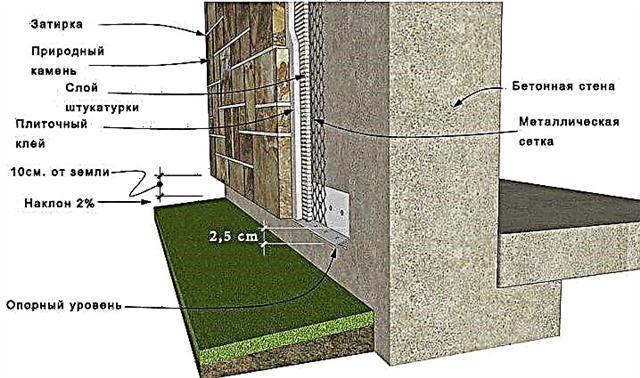
How to carry out styling?
You can lay out decorative tiles with your own hands, but much depends on the material of the stone. To finish the wall with artificial material, it is necessary to stock up on cement and glue, and to lay out the tiles perfectly evenly, you will also need a regular or laser level. For some materials, such as cement-based stone, you will need a grinder with a diamond blade. The front part of the stone has a rough structure similar to that of natural stone, and the second side looks like ordinary tiles or bricks, so you can make repairs in the corridor quickly and without special skills.

A pre-designed plan will facilitate the installation process. For this, you can use special design programs, but if you do not have work experience, then you can do a sheet in a cage. Before starting work, you can place the stone on the floor to determine the fragments, proportions and their installation. As a rule, many people try to “improvise on the spot” and immediately start installation work, skipping the planning stage, however, it is important to remember that building glue dries out very quickly, and it can be difficult to change anything during the work.

Before starting work, it is necessary to prepare the surface - this step cannot be skipped. Without preliminary preparation, the decorative stone will not adhere to the wall. The surface is cleaned of old wallpaper and exfoliated plaster. After this, the primer process takes place, the type of material is selected based on the stone: cement, gypsum, agglomerate, sandstone or clay. If the walls are uneven, then you need to align them.

The wooden wall is waterproofed and then primed. After all the preparatory work, you can proceed to installation, the stone is mounted on a bare wall with plaster, while there should be no dirt on the surface of the walls, this can reduce the quality of adhesion of the finishing material to the base. You can only glue decorative elements on the wallpaper in fragments, but you can not be sure that the paper wallpaper will withstand the stone and will not tear with time.

The stone must be mounted strictly horizontally, so mark the wall with a pencil using a level. It’s more convenient to start work from the bottom of the corner. With a partial decoration of the wall, the back of the decorative element is cleaned with a brush from dust and plaque, after which it is wetted with water, an even layer of special glue is applied with a spatula. The tile is firmly pressed against the wall with mandatory level control. For better grip, you can tap the surface of the stone with a rubber mallet.

Instead of glue, you can use liquid nails, but this method is suitable for mounting a small number of tiles on a drywall. A layer of glue may appear between the tile and the wall; it must be removed with a damp or dry cloth. If this is not done immediately, the glue can dry quickly on the front of the tile or not on the wall.
If you need to cover a large part of the room with stone, then it is better to put glue on the surface of the wall and then fix the tiles one by one. Please note that some stones have buried areas - the side edges have the same color and finish as the front side. Such fragments are used to complete the decorative row. Also, some manufacturers offer ready-made tiles for an external or internal corner, with its help the installation process is greatly facilitated.
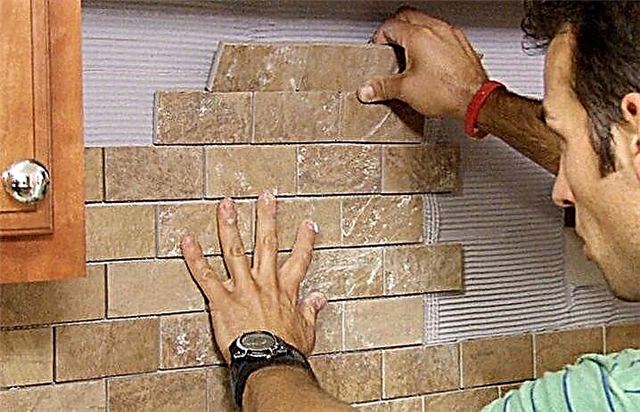
After the glue has dried, you can begin to grout the seams.Everyone decides which seam to choose to make as a stone, based on their wishes and work experience. There are several options: seamless / solid or from a few millimeters to several centimeters. To create the same seams, special plastic crosses or wooden fixing wedges are used.
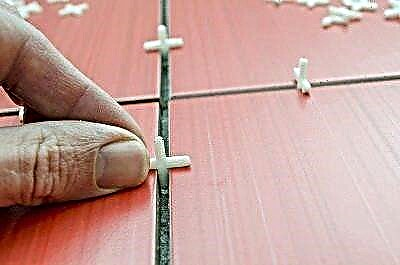
Grout for joints looks similar to masonry mortar. Color can be chosen in tone with the stone or contrasting. Using a construction syringe, the seam is filled with the solution completely or only half the width of the stone. The final step will be the processing of decorative parts with acrylic varnish.

If you decide to decorate the walls of the hallway with decorative stone, you should reconsider the lighting system. Designers advise to abandon the central ceiling lighting and combine evenly spaced lamps on the ceiling and walls. As additional lighting, you can use a sconce or LED strip. Thus, it will be possible to emphasize the relief and natural beauty of the stone.




Decor with stone is a very expensive way of decoration, so calculate your budget in advance. However, do not forget that artificial decorative masonry is very durable and reliable, therefore, over the next 15 years you will not need to spend additional time, effort and money on repairs, and it will only be enough to refresh the color of the walls.
Elegant examples in the interior
With the help of decorative tiles imitating natural stone, you can design not only walls, but also the floor. Such a beautiful coating will not cause much trouble in cleaning and care.




The hall decorated with gray decorative stone looks incredibly stylish and unique.

You can also decorate the arched doorway with decorative tiles.
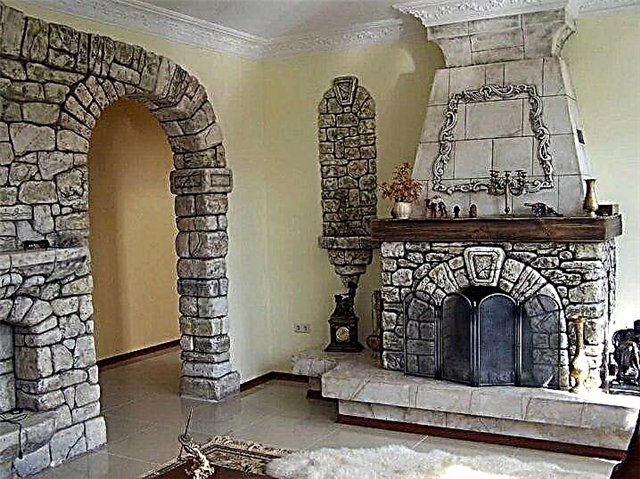
Imitation of brickwork is gaining popularity and is in great demand among lovers of the modern style of the loft.

Everyone who has made repairs at least once knows that the white color expands the space, so choose light-colored materials for a small corridor. At the same time, the interior will not look dull and dull.
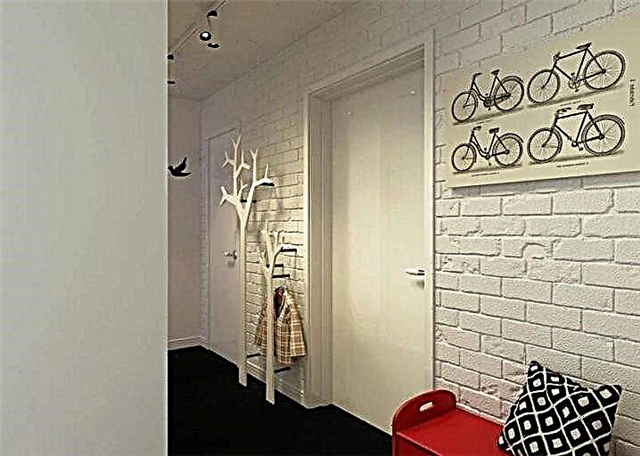
The textured natural surface of the stone stands out against the background of smooth light walls.

An overview of the walls of the hallway with stone, see the next video.
Types of decorative trim stone
Today, there are three types of decorative artificial stone used for interior decoration:
- based on cement
- gypsum based
- agglomerate.
In appearance, these products are very similar to natural stone, only they weigh much less (from 14 kg / m² to 50 kg / m²). The cost is much lower (compared to natural), especially if the manufacturer is Russian or Belarusian. The pluses include easier styling - only the front part is textured, the other three are more like tiles or bricks.
Actually, there is another type of artificial artificial stone - clinker tiles imitating different types of brickwork. It is made from clay almost according to brick technology - it is burned in a furnace and glazed. The difference in thickness is 1-3 cm. This type of decoration is good in many modern interiors - from high-tech to loft.
Samples of clinker tiles to simulate masonry 
Gypsum based
Plaster finishing stone is the most inexpensive of this type of materials. Its second plus - it is the lightest. It is used during installation on drywall, since it simply can not withstand heavy loads. Cons - it is quite fragile, hygroscopic, can get destroyed when wet. Decoration of the hall with a decorative stone based on gypsum is possible only if after laying it is treated with special protective impregnation or varnish on an acrylic basis.
The format of the gypsum tile can be any - a very plastic solution allows you to get any surface and shape 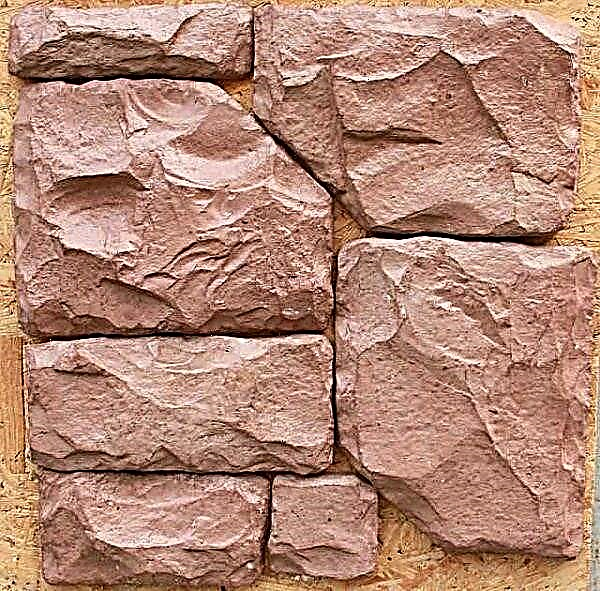
Light shades in the halls do not “crush” and do not add heaviness 
Non-uniform color gives extra volume and charm 
Plaster decorative stone in combination with plaster panels in the corridor - Eastern style 
Decorative stone stands out against the background of smooth walls 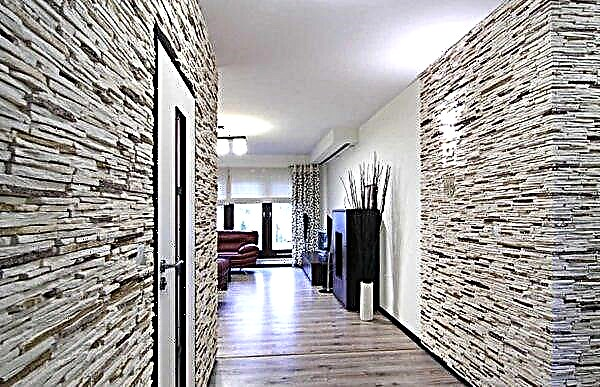
Different color options for one collection. 
Cement based
Strong and durable finishing stone is obtained from a gypsum-sand mixture. It can be washed even with a brush using liquid detergents. Its disadvantages:
- It’s hard to cut. You will need a grinder with a diamond disk, so that there is less dust, you can moisten the tile.
- A lot of weight. This is when compared with a gypsum counterpart, and compared to natural weight, it is more than half as low.
- Higher price. In the manufacture of cement decorative stone, high-quality cement is used, but it costs well. In addition, the production technology affects the price - the cement gains the required strength longer (28 days), and the molded tile must be stored somewhere until this point, and under certain conditions (at a temperature of about 20 ° C and a sufficient humidity of 40-50%). So significant areas are needed for storage facilities, and this is an additional cost.
All these shortcomings are compensated by durability and ease of care, so this is one of the most common decorative stones for interior and exterior decoration.
The combination of decorative stone and wallpaper in the corridor 
This type of decoration in the hallway is convenient in terms of cleaning 
You can completely lay out the walls in the hallway with decorative cobblestone 
Interesting coloring 
Light gray is the thing for a small hallway 
If you decide to make such walls, the lighting should be bright 
A great option for designing a fashionable loft style. 
Agglomerate artificial stone
This type of decorative decorative stone appeared recently. It consists of crushed natural rocks - marble, granite, quartzite - to which polymer resins or cement are added. To obtain vivid colors, coloring pigment is added. This decorative stone looks great - blotches of natural fragments, reflections on the edges of the crumbs ... It really looks good, suitable for finishing work in rooms.
Granite agglomerate 
Samples at the stand 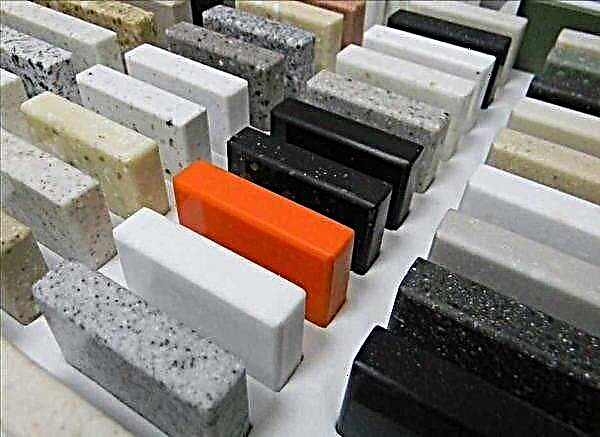
Color options can be many: quartz agglomerate 
Painting methods
When choosing a collection of gypsum or cement, pay attention to the method of painting. Pigment can be added to the solution, and then the weighing tile will be the same color. Tint tones are then applied to its front surface, which give the surface a more natural look. With this technology, even with a chip, the difference will be imperceptible, since the shades are close.
In another embodiment, the pigment is applied only to the surface. Then, when chopped or if necessary, the color will be very different.
DIY artificial stone laying
Before starting work, you need to determine the quantity. It is not as simple as it seems. If you look at the collections, you will see that they mainly consist of fragments of several sizes and shapes. The exception is ceramic stone and masonry collections. Having learned the sizes of fragments, you can estimate how approximately you want to arrange them.
Outline on the walls the intended borders of the finish. Now you can more or less accurately calculate how many "squares" of decorative stone you need. Add about 10-15% to the resulting figure - for trimming and possible changes in the process. This will be the required amount for decoration.
Preliminary layout
Masters with experience working with decorative stone first “figure out” first where to place which fragments, how to turn them. You can make a layout on the floor, you can - in design programs (if you know how to work with them), you can try to draw a plan on graph paper or a piece of paper in a box.The main condition: it is necessary to observe the proportions and not to forget about the seam. It can be quite small - this type of laying is called seamless or solid, and can have a thickness of up to 1 cm or even a little more.
Lay out tiles, choose colors and shades 
Many people skip this stage when decorating the walls with decorative stone alone, hoping that in the process everything will become clear. You can, of course, and so, but keep in mind that the glue seizes very quickly and there is very little time for alteration. The plan will be easier to work.
Surface preparation
You can decorate walls of any material with artificial stone, but all of them require preliminary preparation. If the walls were previously finished with something, the entire finish is removed, a bare wall with stucco should remain. Glue a decorative stone on old wallpapers - wasting time and money in vain: the finish just falls off. Some very light collections can be glued to the wallpaper, but it can only be fragments - several tiles. And then, no one will guarantee that the wallpaper will not tear and everything will not collapse.
The simplest process of preparing walls if they are plastered. Just coat them with a primer. Its type is selected depending on the material (gypsum or cement). Then you can proceed with the actual finishing.
Decorative stone is laid on smooth walls. 
If the walls are made of bricks, building blocks, any other similar material, they are first primed, then plastered with suitable plaster. Alignment of the walls with plasterboard is also allowed. But at the same time, you greatly limit yourself in choosing a finishing stone - you will need to choose from the lightest collections by weight, and this is mainly a decorative stone made of gypsum.
If the walls are wooden, they are first covered with waterproofing impregnation, after drying they are treated with a primer. Then they paint the paint net onto the surface and then plaster it. When choosing plaster, it is advisable to choose from those that "breathe" and will prevent the wood from regulating humidity. With glued tiles this will be problematic, but the decoration of the hallway with decorative stone is usually fragmentary - the tile is glued only in some places, and the rest of the surface will remain vapor-permeable.
What to glue
Most manufacturers of decorative stone are advised to use special adhesives designed specifically for working with this material. They are of three types:
- for lightweight finishing stone weighing up to 30 kg / m 2,
- for heavy from 30 30 kg / m 2 and above,
- for low temperatures (even + 5 ° C).
Glue should be diluted in small portions, strictly following the recommendations of the manufacturers. It is better to stir with a drill with the appropriate nozzle - it is easier to achieve uniformity.
Glue for decorative stone can be ready-made, but it costs more 
You can also glue on tile glue of good quality, only it should be really good - you will have to keep a decent mass. The third option is for liquid nails. This method works great on drywall, with stucco surfaces it is better to use an adhesive solution.
Sticking technology
Plastered or lined with drywall walls are coated with a primer. While it is drying, a portion of glue is diluted. When laying, it is important that the rows of finishing stone are laid horizontally. To achieve this, you can mark the wall. This can be done with a paint cord, or you can draw with a pencil using a hydro or laser level.
Laying decorative stone in the hallway starts from one of the corners. Some collections have special corner tiles - it is easier to work with them. If there are no such fragments, you will have to draw edges with “end” fragments. They are in some collections - their edges are also painted.The same elements are used last in a row where it is necessary that the ends have a decorative appearance.
Corner elements in decorative stone 
Before laying, the back of the decorative stone tile must be inspected. There may be remains of cement milk - this is a thin foamy coating of light color. It must be deleted. This can be done with a stiff brush.
If the air temperature is high or humidity is low, the back of the stone is moistened with water. Then a layer of glue is applied with an ordinary spatula, evened, glue is removed using a gear (with a tooth of 4-5 mm).
Apply glue with a conventional spatula 
Remove excess gear 
The fragment is pressed to the primed surface, moving it slightly from side to side, achieve close contact with the wall, expose the fragment in the desired position. You can tap the surface with a rubber mallet for better adhesion.
To better grip the stone with the wall, you can use a rubber mallet 
This option of laying decorative stone on the walls requires a significant amount of time. It is used when you want to put just a few tiles or along the edges of a large fragment. If you need to lay a significant amount, it is easier to apply glue to the wall, and also remove the excess with a notched trowel. And press the wetted tile to the glue on the wall.
The second technology for laying decorative stone on the wall 
Otherwise, the whole sequence of actions does not change.
If the masonry is seamless, the next element is installed flush. If a seam is needed, the distance between the tiles is fixed with plastic, wooden wedges of the same size, and pieces of drywall are also suitable. If the seam is small, you can use plastic crosses.
Large crosses are also suitable for wall decoration with decorative stone 
Wooden blocks of the same size determine the thickness of the seam 
When working from under the tile, glue may be squeezed out. If it gets on the front surface, it must be removed immediately. Concrete finishing stone can be wet with a rag, gypsum - only dry. The glue seizes very quickly, and then it is almost impossible to remove it without damaging the surface.
The extruded glue is immediately removed. 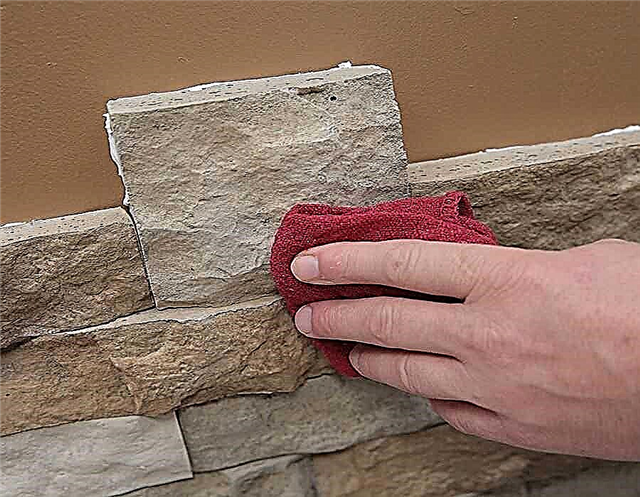
According to this principle, the planned amount of decoration is laid out. When the glue seizes (indicated on the packaging), you can begin to fill the seams.
A special compound is used to fill the seams. By color, it can imitate masonry mortar or be contrasted with the color of the finish.
The composition is diluted with water to a pasty state (the proportions are indicated on the package), put in a special syringe or a dense package with a cut corner. The paste is squeezed between the seams. Depending on the type of finish, the seam is filled almost completely or only by half (up to 5 mm can remain to the edge of the tile). The result is either embossed masonry, or more even.
Syringe filling from a construction syringe 
Until the grout is set, take a special joint and level the seams, giving them a convex, concave or flat shape.
Photo of the decoration of the hallway and corridor with decorative stone
Decorating a hallway with decorative stone is often the decoration of corners and doorways 
Decoration arch decorative stone and switch 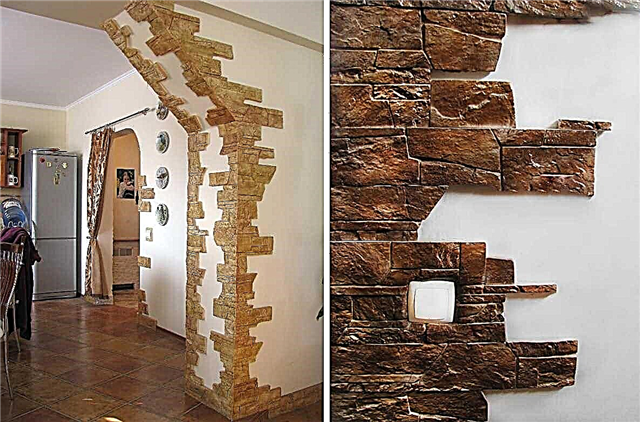
Two door finishes with artificial stone 
Beating a doorway is not easy 
Two different styles, but one material 
Finishes may be quite a bit 
The alternation of strips of plastered walls and decorative stone gives an unusual effect 
If you play with the light, it’s even more beautiful 
In a modern interior, imitation of brickwork is more often used. 
One of the walls in the corridor is decorated with decorative brick. 
Why this option is good - all the "dirty" places are covered with stone 
Decorating the hallway with decorative stone: interior ideas
Decorative stone in the hallway is the most reasonable solution. The original decoration of the walls in the hallway with decorative stone will give the interior uniqueness, will allow you to beat possible corners and niches, doorways and fitted wardrobes. Thinking over the repair of an apartment, usually the last step is taken to the hallway, considering that fantasy is not appropriate here.
Design solutions
The applicable methods for decorating the hallway include: the ability to lay out the entire wall, or finish only part of it. Individual hallway elements will become more expressive.
Decorative wall decoration in the hallway looks natural, fresh, at the same time, rich and elegant. You need to choose a decorative stone or artificial decor, focusing on its price.

Tip. Visually push the narrow walls, give them the original antiquity of the Middle Ages palaces, will allow the bas-relief light stone.
- The use of a shell rock with small coral inclusions in the design, together with rough stone chips, delight amateurs.
- A wall completely finished with stone acquires a heavy, pressing effect.
- The stone design in combination with stretch ceilings, dense wallpaper, simple plaster looks amazing. The fantasy of the performer is the only limitation.
- The combined decoration of the hallway with stone and tile is more functional, looks more organic, allows the use of a warm floor, which creates additional comfort. Of course, the decorative stone looks more solid compared to the artificial decor, but it’s more difficult to care for it.
A feature of the manufacture of artificial stone allows you to make tiles of various shapes used in the decoration of curved surfaces of arches, doorways.
How to install
The laying of stone elements is quite simple. Therefore, wall decoration with decorative stone in the hallway is quite do-it-yourself. A small percentage of self-confidence, minimal skills in finishing work, several video lessons or workshops, and nothing is impossible.

The preparatory work involves the complete cleaning of the walls of wallpaper and old plaster. In advance, the location of electrical wiring, switches, lighting should be provided. If there is no need to form arches, then the alignment of the walls can be done using putty.
Remarkably aligned walls with drywall. It allows you to use built-in lights, LED backlighting, which makes the entrance hall trim with artificial stone more original.
The tile is fixed with special glue, “liquid nails”, putty mortar.
Phased work, instructions
Self-decoration with decorative stone in the hallway involves the following procedure:
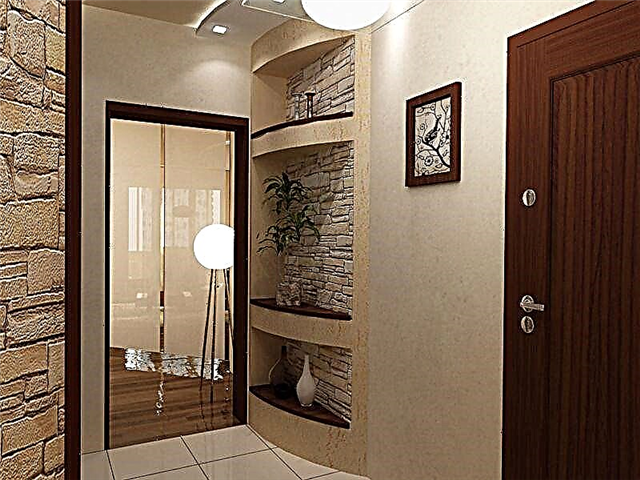
- Completely remove all old finishing materials. Opened defects and cracks on the walls are removed using solutions. Only those surfaces with irregularities exceeding 5 cm per square meter need to be stuccoed.
- Putty finally level the entire surface of the wall. Apply a primer.
- The marking of the walls is necessary for the stackers with a minimum skill of finishing the hallway with stone, tile. To do this, use beacons. These are specially installed stones from which the masonry is counted.
- It is better to arrange the beacons on the bottom row of tiles. Pulling the cord, use the level to determine the horizontal line.
The laying technology from bottom to top from the corner is most convenient. Row after row, climbing up the wall, carry the cord, because the tiles may vary slightly in size and the pattern is deformed. - Be sure to consider the location and width of skirting boards and cornices.
Installation of decorative stone
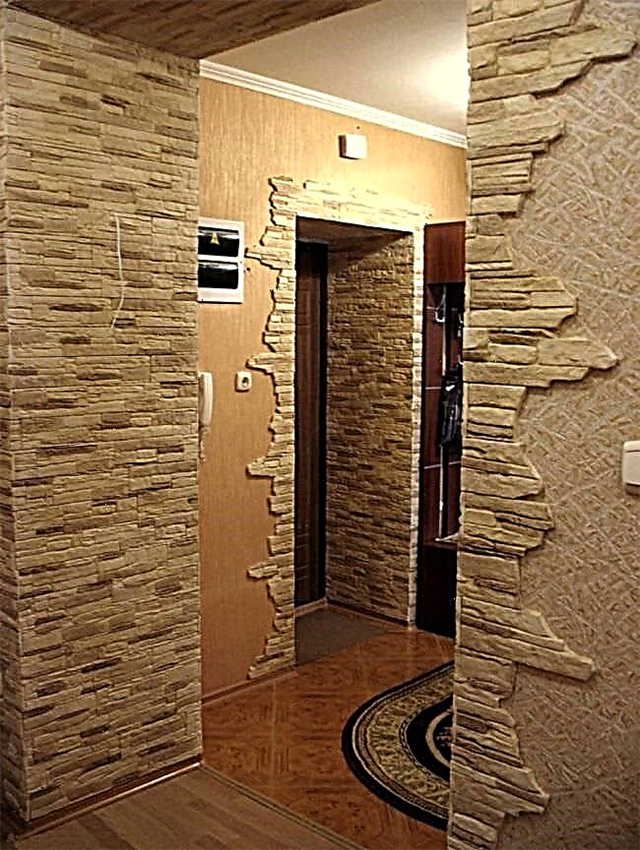
- Before directly installing the decor on a wall or other surface, sort the stones (shades may vary slightly even in one batch).Take your time and lay out the future decor element on the floor.
So the masonry is visible immediately, and it will be quite difficult to get confused during the installation. - Tile masonry is performed according to the instructions for a particular finishing material. Bulky decorative stones or large artificial tiles are fixed with adhesive solutions. They must be applied directly to the tile with a notched trowel.
- "Liquid nails" are effective with a small size of artificial stones.
Related video:ARTIFICIAL STONE in the interior ❖❖❖ Decoration with decorative stone hallway
Tip. It’s easy to fit tiles to one size. Artificial stones are easily sawn, ground, cut. Using a hacksaw for metal or pliers, you can slightly correct the defects.

After laying the stone tiles, leave it at least a day to dry. The grouting composition can be used to treat the seams that have arisen only after that.
Artificial stone in the interior of the hallway (photo)
Why choose an artificial stone in the hallway? Compared to natural stone, artificial analogues have a number of advantages.

- Light weight, which is very significant in the processes of transportation and practical use.
- High strength. By this indicator, artificial decorative stone is slightly inferior to natural, moreover, in some cases even stronger and is able to serve as a facing material for more than a dozen years.
- Like natural artificial stone is not combustible. And finally, artificial stones are easy to lay and the complexity of this process is not much more difficult than laying traditional ceramic tiles.
Varieties of artificial stone for the hallway
Today, all artificial stone, based on the technological features of manufacturing, is divided into two groups: stone based on colored concrete and stone based on gypsum. Visually, these finishing materials are almost impossible to distinguish.
But now a lot of options have been developed for facing gypsum stone coated with a special waterproof composition, in extreme cases, water-repellent impregnation can be applied independently.

DIY artificial stone laying in the hallway
Having decided on the design, you can accurately calculate the amount of stone that will be used. Modern industry, specializing in the production of building materials, produces facing stone of various sizes and shapes, greatly simplifying the task.

To begin with, you should prepare the surface for finishing with a facing stone. The wall must be leveled and plastered, turning the surface into perfectly smooth without potholes and protrusions. For a better setting, it is recommended that the surface be primed. After the preparatory work, you can begin the installation process.
It is best to draw the alleged pattern on the wall with a pencil. Masonry begins from below, from the floor, it is recommended to use a level in the work. As a fixing solution, you can use liquid nails for lightweight artificial stones.

For heavy concrete stones it is recommended to use glue for a ceramic tile. Since the glue hardens quickly enough, it is recommended to cook it in small portions. The final step in laying is considered to be grouting, after which it is recommended to process the lined surface with varnish.
Decorative stone in the hallway: photo of interior design.
Decorating the hallway with artificial decorative stone is an expensive pleasure. But after you see the transformation of your apartment, you will forget about money. The result is worth it.
It goes well with tiles, stucco decoration, wallpaper and various types of stretch ceilings. And this, in turn, allows you to unleash your imagination when combining various finishing materials.Decorating a hallway with a decorative stone will not require much effort, since among a large number you can distinguish decorative elements, rounded and corner inserts necessary to decorate door niches and openings.

Using decorative stone, you can finish absolutely any surface: concrete, brick, metal elements and so on.
How to make the finish yourself?
The first thing to do is prepare the foundation. It is necessary to remove the previous finish, which has ceased to hold tight: tiles, plaster, wallpaper. If the wall has irregularities, with a surface difference of more than five centimeters, it will be necessary to carry out a primer and plastering.

The next step is marking the wall. After this, the guide stones are fixed. During the marking, the height of the skirting boards and cornices must be taken into account. Now you need to make a check mark. For these purposes, any corner of the hallway is perfect. You can choose any height. To perform the mark, you will have to use a laser level, or a water level, and then transfer it to other angles.
After creating a tag. it is necessary to measure the distance between it and the first level of decorative stones. You can also establish risks or hammer nails in the corners, between which then pull the rope. Decorative stone can be laid back to back. It is important to lay the stone in even horizontal rows. To apply glue to a wall or stone, it is enough to use a spatula-comb.

The last stage - mashing seams. This must be done exactly one day later. Just in this time glue will grasp. To grind the seams, use a special compound for mashing.


Thin decorative stone
If you want to make a decorative stone, you can do it yourself: for this you need a plastic or silicone mold, a dry gypsum mixture, and coloring pigments. To buy all this is not a problem, in every construction store a large selection of mixtures and forms. Self-production of finishing material takes more time, but it saves money on repairs.
Tools and materials
For laying decorative stone, you will need the following tools and materials:
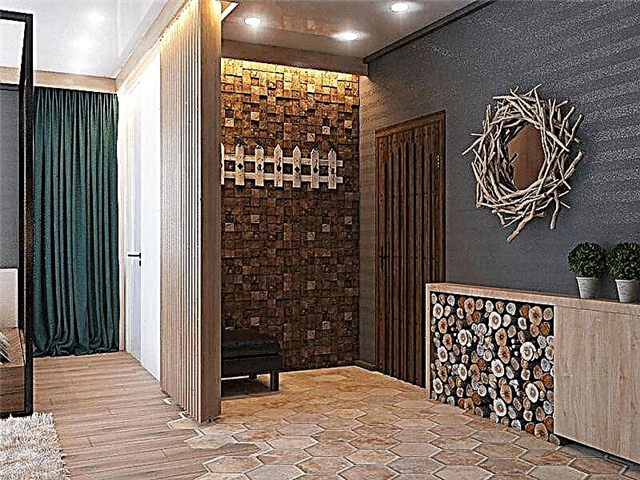
- Wood saw for trimming stone
- Spatulas (small 7–9 cm, medium 15–17 cm and average serrated 15–17 cm) for applying glue to plates
- Simple pencil - draw slice lines
- Bucket or basin for glue
- Sandpaper or chisel to fit plates
- Kitchen sponges are used when puttying putty
- Tile adhesive (liquid nails)
- Putty - gloss over joints between stone slabs
- Paints (usually come with a decorative stone) for coating the joints after putty
- Water-based varnish for the treatment of joints after painting
Finishing technology
Decorative artificial stones are made of colored concrete or gypsum-based. Each builder finds its advantages and disadvantages in each of these types. For example, for beginners, gypsum-based stones are the best & mdash, it is easier to work with them, they themselves are easier and, by the way, cheaper than concrete decorative stone.

As for the finish - there are a number of nuances. Finishing the hallway should begin with the preparation of the surface for further work. Swings that reach more than 5 mm must be plastered, and in order for the wall to have good adhesion, it must be carefully primed.
Important! The decorative stone is by no means glued to the wallpaper.
You need to start with the fact that the tile itself should not be immediately glued to the wall. It is advisable to draw on a piece of paper the location of the stone slabs and lay them on the floor. So you can pick up the elements in size, thickness and understand where it will be necessary to make the adjustment of plates that will fit together.
After laying, of course, there will remain some defects, chips, cracks and other trifles. The easiest way to fix them is with paint, which should be attached to the decorative stone. This paint is fully consistent with the color of the finishing material and perfectly hides all the flaws.
Design Tips
In order to give expressiveness to a stone wall, it is possible to apply a finishing spraying to the laid stones. It is desirable that the color be slightly darker than the stone itself. You can highlight the contour along the edges with the help of gold or bronze contours, which will give this element of decor even more originality.

If you cover an artificial stone with matte or acrylic varnish, it will last much longer and will shine beautifully when light enters it. It is important that the decorative stone is in harmony with other finishing materials (wallpaper or paint).
Do not get too carried away with stone finishing, since in large quantities this decorative material can make the interior bulky and “crushing”. The use of decorative stone in decoration is a completely modern and very popular solution. This finishing option requires a creative approach and well-thought-out styling technology in advance.

Artificial stone trim in the hallway - an original solution for a unique interior
There are many reasons why a decorative stone in the hallway as the main element of wall decoration is exactly what is needed. Let's consider some of them:

- Awesome design. To begin with, thanks to which this material is generally chosen first of all - it has a crude, "real" beauty. A man who since childhood dreamed of living in a medieval castle cannot but appreciate this option! And if in the bedroom the stone wall decoration would not be a very good solution (evokes thoughts of cold), then the artificial stone in the interior of the hallway looks gorgeous.
Artificial stone, like natural, is ideal for decorating the hallway
- Relatively light weight. If the owner of the corridor is not a very poor person, and even a lover of all natural, then you can give preference to a real stone, but it has one serious drawback - significant weight, because of which the walls will probably have to be strengthened beforehand. Decorating the hallway with decorative stone provides only a thin layer of material, and that one weighs less than natural of the same volume.
- Lack of difficulties when laying. Since the decorative material was originally made for wall decoration, it is already fully adapted to this specificity - there is no need to “drown” it in the surface, it is easily laid out with a thin layer. It is also mounted very simply, cement and glue are enough for this. Since the finished surface does not provide perfect evenness, the level will not be useful to you.
- Decorating the hallway with decorative stone can increase the fire resistance of the room. Artificial stone, like natural stone, does not burn in the fire, which compares it favorably with most other finishing materials.
- The stone in the interior of the hallway is also good because it is an almost eternal solution. All other decor elements usually wear out and require replacement much earlier, but the stone, with due respect and basic care, can last at least a decade and a half, which allows for a long time to forget about the repair.
How to fit a decorative stone in the interior of the corridor
Like any other finishing material, a decorative stone in the interior of a hallway can turn out to be both a very successful solution, and a pointless waste of money on decoration that will only spoil the appearance of the room. It all depends on how well the design idea is thought out and logically completed.

Let's start with the color scheme.The entrance hall usually not only has no windows, but is also far removed from them, therefore, twilight reigns here even during the day, and there is absolutely no need to thicken it even more. It is better to give preference to a stone of light tones - in electric light it will shine beautifully and reflect light.
Such a decision, with the right approach, looks very stylish - one gets the impression that you are in an old building that looks a bit like picturesque ruins. The shade of the stone should not differ much from the rest of the finish, otherwise the individual elements of the decor will not be in harmony with each other.
The decoration of the corridor with artificial stone goes well with green plants. A professional designer with the help of a well-chosen type of plants is able to completely change the perception of the interior, as a result of which the masonry may seem cute and picturesque, or, conversely, acquire a special wildness. You can try to experiment with this yourself, but only a specialist will be able to easily achieve the planned result.
In this situation, small, uniformly distant light sources of relatively low brightness are much better suited to create uniform illumination of the room. If the interior has certain accents - mirrors, paintings, and so on - it is better to highlight them with additional lighting.
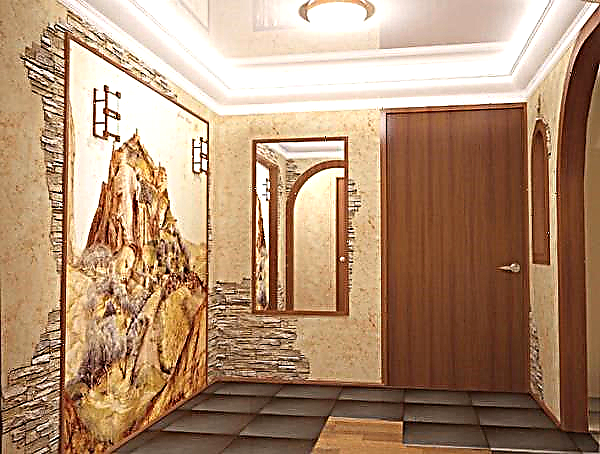
The combination of artificial stone with a classic style
The owners, guided by the classic interior design, are worried about the possibility of combining decorative stone, as a wild material, with sublime and sophisticated classicism. In fact, they are fairly well linked together, but the classic usually requires a significant area of the room.

Decorative stone will help emphasize the classic style in the interior. Moreover, in some cases, it is the stone that helps give the corridor classic notes. Speaking of classics, they usually imply a certain fundamentality and solidity, and masonry is ideally suited for these purposes.
To achieve the goal, lay out not only walls, but also the floor with decorative material. At the same time, it is important not to overload the decor with numerous elements, because an excessive variety of details will only spoil the overall impression of the room.
Decoration of doorways and walls with artificial stone
Decorating the hallway with decorative stone and wallpaper is a relatively expensive type of cladding, but a respectable view of the walls is worth the money invested. The use of artificial stone opens up wide scope for the manifestation of designer imagination.
Decoration with a decorative stone of the hallway is quite easy, as there is a large selection of decorative elements, corner and rounded inserts necessary for the design of doorways and niches. Artificial decorative stone is suitable for finishing any surfaces - concrete, metal structural elements, brick, wood, etc.

Artificial stone in the hallway. Interior Design
Before using this or that material, for a start it is necessary to study all its features in order to correctly make your choice. Artificial stone is a mixture of marble placer with various minerals. The natural appearance of the stone, reminiscent of natural material, indicates its high quality.
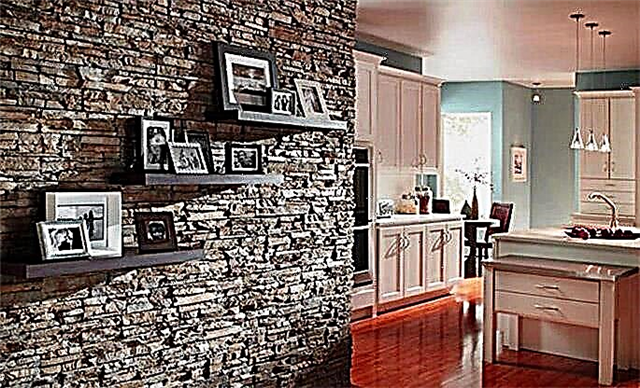
This criterion will help with the selection. Also, no need to save when buying. Do not think that natural material is more expensive than artificial stone. Its price may even exceed the asking price for natural material, since additional resources are spent on its production.
The approximate cost may vary from 500 to 3000 rubles per square meter. Of particular importance is the producing country. You should also pay attention to the cut of the stone.The surface should be as smooth as possible, without the content of large elements. Otherwise, it threatens the formation of cracks and chips.
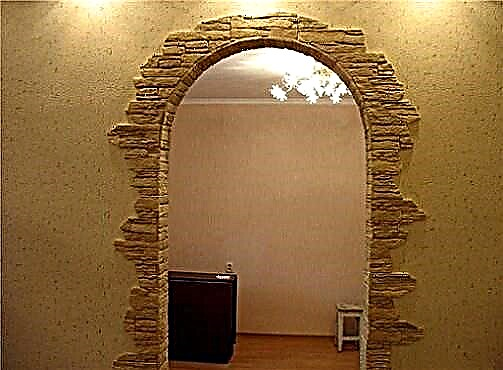
Artificial Stone Hallway Interior
Particularly harmonious looks artificial stone in the hallway. However, the design of this room requires some harmony. Contrast and brightness are appropriate exclusively for spacious rooms. But not everyone can boast of a huge hallway. Often, contrasting shades visually reduce space.

This fact should be considered when choosing an artificial stone. Natural shades that differ by just a couple of tones from the color of the walls are ideal. Also, do not completely cover the walls in the hallway with decorative stone. It is enough to make a few blocks to emphasize. For example, you can make a stone doorway or lay it out along the floor line. You can also stone a niche for a cabinet. The modern design of the hallway with artificial stone involves asymmetry. It can be laid out in a chaotic manner, without trying to build the correct shapes.
Steps of decorating the hallway with decorative stone
- Surface preparation for facing.
- Complete removal of old finishing materials.
- Identification and elimination of various defects on the surface (chips, cracks, depressions).
- Plastering areas with pronounced differences. Putty coating to a perfectly even condition.
- Primer surface treatment.

Finishing the hallway with artificial stone requires some knowledge and skills. However, even a novice can do such work.
Styling process
Wall decoration begins with marking. Of course, experienced builders can skip this step. As a rule, they use only the construction level. But this is beyond the reach of a beginner. Therefore, it is better to immediately place markings in the form of lighthouse stones on the wall.
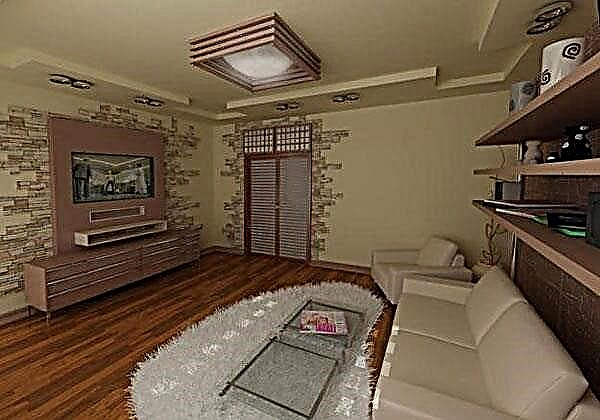
They will indicate the boundaries of the masonry. Laying can be started from any corner of the room. It is there that you need to put the first mark. Then, using the level, you need to set the connection marks. Between them, for accuracy, you can twine.
Finishing should be carried out, given the thickness of the material. Large stones are coated on the back with a glue-based solution. For application, a notched trowel is suitable. If the stones are small, then you can use the so-called liquid nails. Before laying, stones should be sorted by shade.
Colors in each batch may vary. To facilitate the process, put the intended pattern on the floor to determine the installation procedure for each individual element on the wall. Glue is applied to the back surface, and the stone is firmly pressed against the wall. Laying is done with a level so that you can immediately eliminate bumps.

When the joint is laid out in the first row, you can start laying the next in the same sequence. After the entire surface is framed, it must be dried within 24 hours, after which it is necessary to process the joints between the stones with a special solution.
Types of artificial stone for hallway design
Depending on the production technology, decorative stone may in its basis contain either colored concrete or gypsum. There are practically no visual differences. However, their weight varies significantly. Concrete stone is much heavier than its gypsum counterpart. It also affects the cost of the material.
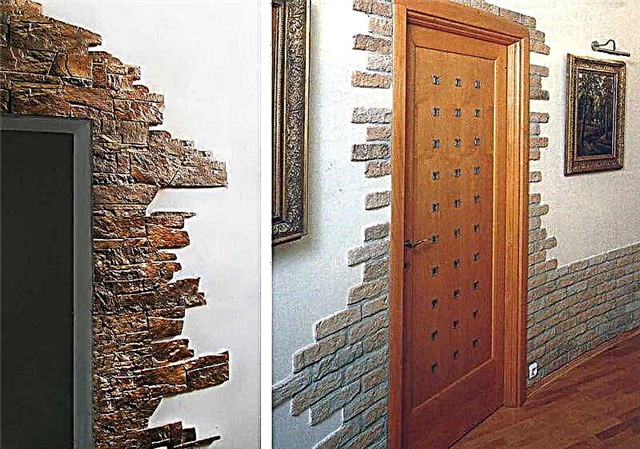
An artificial stone, the price of which is higher, is supposed to be made of concrete. However, the difference in cost is not so significant. As a rule, it is not more than 200 rubles per square meter. The only drawback of gypsum stone is its low moisture resistance. Some manufacturers cover the material with a waterproof emulsion. This can also be done independently.
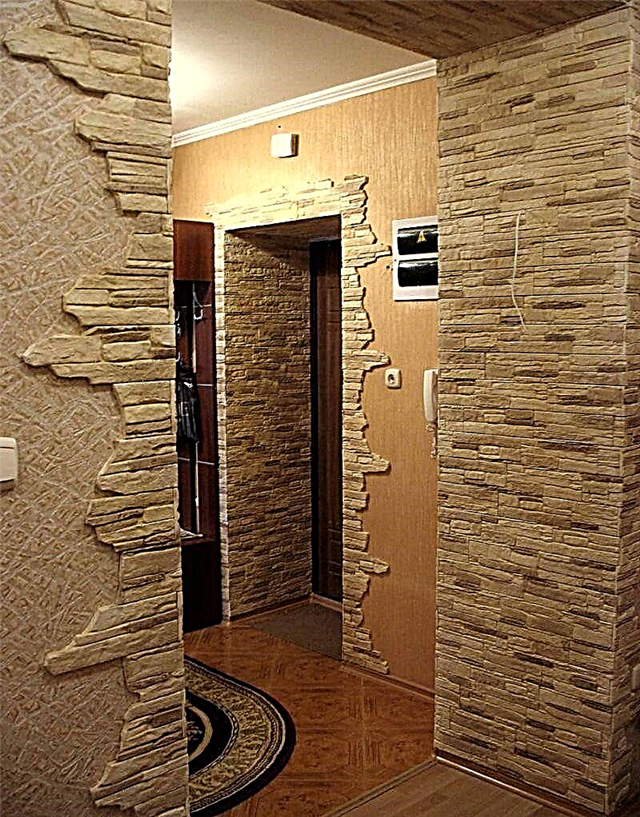
Stone in the hallway interior - advantages of using
- the correct shape and light weight of decorative stone greatly simplifies all the finishing work with it,
- it looks respectably with ceramic tiles, discreet wallpaper and carpet, and with stucco moldings, wooden elements or a stretch ceiling,
- the various texture and texture of the finishing stone, its wide color scheme adequately emphasizes the originality of any interior and its unique style,
- artificial stone is not susceptible to processes such as rotting or corrosion,
- easy to care, flexible stone can be washed with an ordinary soap solution,
- visually attractive, decorative stone is not only pleasing to the eye, but quite pleasant to the touch,
- convenient and practical in work, it expressively emphasizes the geometry of doorways and forms the ergonomics of space.
In the construction market, finishing stone is presented in two versions:
- Natural decorative stone made from many types of rocks: marble, granite, diorite, quartzite, sandstone, etc.
- Artificial decorative stone. which is made of gypsum and cement.
A significant difference in price is the only difference between natural and artificial stone. Outwardly, they are practically no different from each other, which allows you to create a truly inimitable interior in the hallway, both with impressive financial investments, and without them. It all depends on the capabilities of your wallet and outlook on life, in particular on the decoration of the hallway under a stone.
Artificial or wild stone in the interior of the hallway - which is better?
Slate and malachite, like stone for wall decoration, were widely used to create chic palace interiors several centuries ago. Walls, floors and fireplaces were lined with solid stone.
Related video:Stone decoration in the interior
Unfortunately, with all its numerous virtues created by nature itself, one crack is enough to break the whole structure of natural stone. The owners of the hallway and the corridor (the most passable place in the house) will have to protect their walls as much as possible so that no one accidentally damages the marble, granite or basalt finish. It will be problematic to repair a crack or chip that has appeared even for specialists with extensive experience.
Fortunately, with the advent of artificial stone - an innovative material that qualitatively mimics the texture of natural minerals, it has become possible to create easily restored designer compositions. Flexible stone was especially popular in the decoration of the halls - a composite of the most complex composition, made on the basis of marble chips, natural pigments and environmentally friendly polymers. Plastic and shockproof, it easily takes the necessary shape of doorways, niches, corners and rounding arches, and can be used for any kind of finishing work.
Wall decoration with decorative stone in the hallway and corridor - proper laying of stone on the wall
Surface preparation for stone cladding

- Before starting the basic finishing work, it is necessary to clean the surface of old materials.
- After making sure that there are no defects of all kinds on the walls (recesses or cracks, which are removed by means of fastening solutions), you can start surface treatment with a layer of plaster, and then putty.
- In order to improve the adhesion of the decorative stone to the base, it is recommended to treat both layers with a primer on an acrylic, alkyd or mineral base.
- Without certain experience, it is quite difficult to lay a stone on a wall without markings, having only the construction level at hand. Therefore, experts recommend preliminary marking on the surface, setting the reference points on the wall - “lighthouse” stones.
- Then, using a laser level or the same level, fix identical marks and connect the “beacons” closest to each other at the level of the main row using twine.

- To facilitate the process of decorating the hallway with stone, you must first sort all the elements according to color shades and lay out an approximate picture of the future finish on the floor.
- Laying is best to start from the corner, or, in extreme cases, from below, strictly observing the thickness of the cornices and skirting boards.
- Large stones are laid end-to-end to each other with a mixture based on glue, which is applied to the wrong side with a notched trowel. Material with a small thickness is mounted with high-strength adhesive, for example, “liquid nails”.
- It takes about a day to dry the surface treated with decorative stone. Then you can grout the seams based on a special solution.
Important! Artificial stones, unlike natural ones, lend themselves perfectly to any processing. They can be cut, broken or even sawn in order to fit stone elements to the desired size.

Most often, stone is not lined with the entire entrance hall, but with one of the walls. This allows you to zone a small space, highlighting its main part. Particularly spectacular look doorways lined with "chipped" stone. This interior design clearly resembles the entrance to an ancient, dilapidated castle.

Stages of decorating the hallway with decorative stone
Is it possible to finish the hallway with a decorative stone yourself, so to speak, with your own hands? Such a question today can often be heard from apartment owners who carry out repairs on their own and want to use natural materials to create a cozy atmosphere inside their home.
If we talk about the economic side of the decoration, we note that decorative stone is not cheap material, it will require certain and considerable financial investments. But this money is worth investing to create a truly unrivaled interior space.

Although today for those who do not have large incomes, but want to change the interior design of an apartment or house using stone, the construction market offers artificial materials made using modern technologies.
Stages
Firstly it is necessary to prepare the facing surface. To do this, you will have to completely remove the old finishing materials. Then the surface is examined for defects in the form of cracks, grooves, chips, which are removed using fastening solutions.
Second phase can be called marking. Many experienced craftsmen make laying without any markings, using only the construction level. For beginners, this is not always possible, therefore, it is recommended to make markings on the wall and install beacon stones, which will serve as reference points for masonry. To do this, you need to set a mark in any corner of the room, where the process will begin. Then, using a level or a laser level, it is necessary to establish the same marks and the nearest, that is, neighboring ones, to connect with twine at the level of the first row.
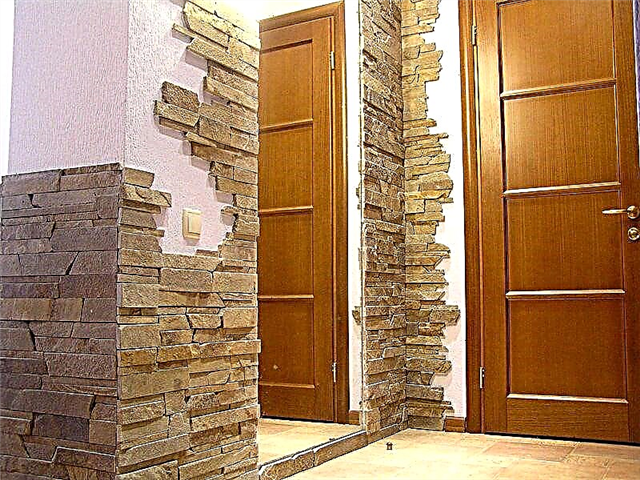
By the way, stone laying can be started according to the technology from top to bottom or from bottom to top, this is not important. It is important to start laying from the corner. But most masters prefer to stack from the bottom, it's just convenient. It is important to strictly observe the thickness of skirting boards and cornices.
Next stage - This is the masonry of the finishing material itself. Here a lot will depend on the thickness of the material. If this size is large enough, you will have to use glue-based solutions that are applied to the back of the stone with a notched trowel. If the thickness of the stones used is small, then glue like "liquid nails" is also suitable.

Before laying, they must be sorted by color shades, because in each batch the stones can differ.Then lay them out on the floor, in that order in which each element will be laid on the wall. It will just make the process easier.
Then glue is applied to the back side, and the stone is pressed against the wall surface. It must be checked by level and, if necessary, immediately corrected. Stones are stacked butt to each other. Such images fit the first row, followed by the subsequent rows in the same sequence.
After fully laying the entire surface to be treated, there is a need to leave the finish for twenty-four hours to dry. And only after that you can wipe the seams between them. For this, a special solution is used, made on the basis of a trowel composition.

In this way, you can finish the hallway with stone and create a beautiful, cozy and unique interior. As you can see, it’s not so difficult to lay down this material. Here it is very important to correctly approach the performance of all work and accurately observe all stages or stages of this process.

Luxury interior decoration with artificial stone (photo)
The most popular was the stone for the interior based on concrete, porcelain stoneware, conglomerates. This is due to the low cost with excellent quality, aesthetic effect, long life of the interior decoration. Paying attention to the photo of the interior of the apartment with masonry, it becomes clear how diverse the range and prospects of using stone are.

Artificial stone for the interior during interior decoration of the apartment has many advantages:
- light weight
- ease of installation
- wide palette of colors,
- an extensive list of imitations of natural analogues,
- durability,
- ease of care.

Depending on the main component, an imitation of one or another natural monolith is performed, repeating its color, texture, features. To understand what type of artificial stone you need, refer to the photo from the Internet, catalogs. On the basis of conglomerates, a smooth stone is produced for the interior, used for internal work. Stones in the interior, such as marble, onyx, malachite, that is, minerals differing in depth, the play of color and its shades, are popular in use.
Wall cladding in the living room interior
The beauty and reliability of stone walls were first appreciated by primitive people, but modern interior design offers lighter options. To place accents, give the room a style, set the color, season it with eco-friendly notes - the artificial stone in the interior easily copes with this.

Wild stone in the interior is often used. Natural material determines the status, gives luxury, sets the tone for the rest of the filling of the house. But its practicality is very controversial and often very expensive.
Using masonry as a wall decoration over the sofa, the issue of additional surface decor is completely removed. The play of colors, textures, the ability to layout different breeds of material, the layout of the picture - these opportunities open up scope for a creative approach to decorating a house.

Related video:STONE CORRIDOR FINISH / INTERIOR PHOTO
Masonry kitchen
The simplicity of care for artificial materials and the degree of their safety make it possible to use them in the kitchen. This room needs a careful selection of finishing materials, because there is constant contact with water, heating surfaces, food.
Artificial stone is made taking into account consumer needs - it is easy to clean, non-toxic, treated with dirt and water repellents. Moreover, this material is refractory, almost as well as natural.
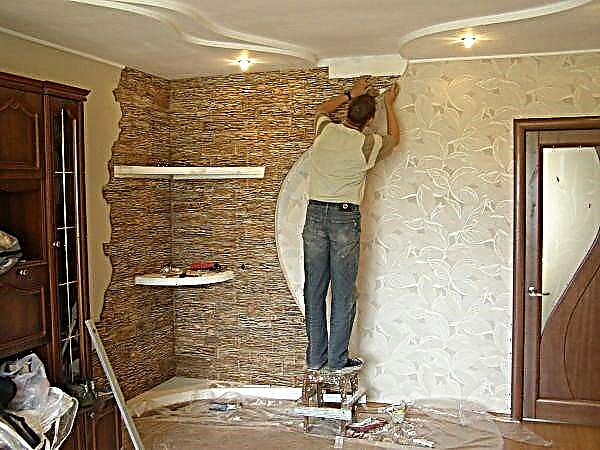
Facing the apron of the working area in the kitchen with stone, sea pebbles, slate or another breed subconsciously gives a person a sense of stability, comfort, permanence of the hearth, the torn edge of the stone is pleasing to the eye.The color of the facing stone is selected based on the overall design of the room - the contrast or mutual addition of color palettes in the interior of the kitchen comes only from your desire, the material always plays in favor of the interior.
Decorative stone in the interior of the hallway
Artificial stone for the hallway is a real find. The first room we enter from the street is often unsightly due to its small size. But, if you lay out the walls or floor in the hallway with a stone, then the impression will immediately change for the better.
If you plan to use artificial stone in the interior of the hallway, then it is worth determining the color and styling possibilities. If the entrance hall is small, then the walls, completely covered with masonry, can turn it into a stone bag. In this case, the light color of the material will help.

Fragmented styling will be more relevant. Approaching the design of the walls of the hallway with creative and at the same time practical approaches, several urgent problems can be solved.
Related video:Decorative stone, hallway design, arches, decor, mirror
In the hallway of the apartment, they often lean on the walls, it is here that street shoes stand and outerwear, wet umbrellas and other accessories that damage the walls and floor. Having laid the corner of the room with an artificial stone with a torn texture, even if the color is light, you can avoid mashing surfaces, the stone is a very resistant material and can be washed perfectly.

The use of stone slabs in the floor lining in the entrance hall where the shoes are based maintains the cleanliness and safety of the remaining floor surface. Artificial stone in the interior will appreciate the performance that is not inferior to natural counterparts, but much easier to maintain.
Stone interior in the bedroom
The stone for the interior in the bedroom of a city apartment is a rather unexpected reception, but the photos of the bedrooms convince of the appropriateness of such decor. Whatever the size of the room and its color, it is always possible to bring decor elements into it, and moreover, the interior will not be disturbed. For a large bedroom, wall covering above the head of the bed is quite suitable, as a highlight of the interior.

Small bedrooms are decorated with fragmented stone tiles. They can be placed under the ceiling as a frieze, on the floor like a baseboard, or in several places on the walls. A good solution would be to finish a small space near the head of the bed, in places where there is a point of light, to veneer a window or doorway, to maintain the overall color of the room.
Stone decoration
Decorative stone is used in design not only as a facing material for walls or floors. It is suitable for decorating individual elements of the exterior of an apartment or house. The working island in the kitchen looks luxurious with side walls lined with stone tiles.
Related video:Laying decorative artificial stone in the apartment

A floor vase imitating a stone vessel can be made with your own hands, for this it is enough to stick on the base, the so-called flexible stone.
It is a thin section of natural sandstone laid on a plastic base. The material is flexible, durable, resistant to damage, and for laying it requires a breadboard knife, glue and a pencil for marking.

Flexible stone is an innovative material that has concentrated all the aspirations of the builder, designer and consumer: naturalness, ease of installation, beauty and inexhaustible possibilities for shaping the decoration.
Wall design in the hallway: Photos
The most difficult thing is to arrange a small hallway, since in a small area you need to equip a place for clothes and shoes and at the same time not to make the room even more crowded. If you cannot literally push the walls apart, you can do it visually.A bright hallway looks more spacious, so the color of the walls should be in bright colors, regardless of whether they are painted or glued with wallpaper.
The walls in the corridor get dirty more often than in other rooms, so their finish should be durable and easy to wash. Paint and wallpaper are selected resistant to abrasion and with the ability to wash them with cleaning products.
Original look walls decorated with different materials. In this way, even a narrow corridor can be divided into zones. An entrance area is arranged at the front door, a dressing room at the hanger or at the closet, and if possible, the recreation area is also separated.

Photo wallpaper application
If in the hallway one of the walls is free of furniture, there is a great opportunity to decorate it with photo wallpaper. Now you can not just go to the store and choose a photo wallpaper with a picture that will be offered to you, but order them to print using a independently selected file and create an individual, one-of-a-kind style. This expands the possibilities of decorating the walls in the hallway, and helps to realize exclusive design ideas.
For a small entrance hall, you can choose a landscape with a panorama that creates the impression of the presence of air and space.
Decoration Materials
Wall decor is most often used wallpaper and paint, but these are not the only materials for decoration. The entrance hall will look original, in which part of the wall is lined with artificial stone, for example, in the area of a mirror or decorative arch. This will be especially practical near the door, where dust from shoes and rain water from umbrellas get on the walls - it is easy to clean and practically does not lose its original appearance.
A practical idea in the design of the hallway is decorative plaster. It is applied in a very thin layer, so it will not “steal” centimeters even in the smallest and narrowest corridor. The plastered walls are painted in any color with acrylic water-based paint.

Panels in the interior
Panels - a common option in the design of the hallway. They separate the lower part of the walls, which is most susceptible to pollution, thereby simplifying room cleaning. You can make them from laminate, MDF panels or plastic, as well as a suitable type of decorative plaster or from corian.
Select the material for the panels a few tones darker than the top of the walls. Wood paneling is always in fashion, especially since a laminate of this structure is made with imitation of any wood species, from bleached oak to wenge. You can separate the panels in a less expensive way, using wallpaper or paint a few tones darker than the top of the walls.

Options for wall decoration in the hallway - practical and beautiful
If we compare the rooms in a modern apartment on the level of patency, then the hallway will be in first place. This fact is very important when choosing materials for decoration, because it must be reliable, durable and easy to modify. The last point is especially relevant for those who have small children or pets, because of which the walls are constantly susceptible to additional pollution and mechanical damage.
Constant fuss with bulky items in a room not the largest will necessarily lead to scratches or chips on the walls, so the finish should provide a reliable and durable coating on the walls.
This is due to the fact that the hallway — this is a place of maximum concentration of all moisture and dirt from the street without adequate lighting, constantly exposed to mechanical stress. That is why the ideal finish should be wear-resistant, easy to care for, non-marking and consistent with the overall design of the entire apartment or house.

Decoration with decorative stone hallway or corridor
If you decide to decorate your hallway with decorative artificial stone, you need to know that there are two types of this material:

- Gypsum based
- Based on colored concrete.
Gypsum artificial stone for decoration is almost twice lighter than concrete.This fact becomes especially important when it is required to decorate a hallway with decorative stone and fasten it on a plasterboard wall. It is easy to cut, unlike concrete, which may require a grinder to cut.

The cost of gypsum is less than concrete. But decorative gypsum-based decorative stone has a significant drawback - lower porosity (read strength) and fear of moisture. But here, the construction market offers a way out, making it possible to purchase gypsum polymer stone for wall decoration, already covered with a protective layer.
When buying and choosing an artificial stone for decorating the hallway, you can not buy corner fragments, but buy only ordinary stones and join them yourself. After all, the corner elements of such tiles are more expensive.
The procedure for decorating the hallway with decorative stone
Decoration of the hall with decorative artificial stone should be done only on even clean walls! It is necessary to first remove all previous finishing materials (wallpaper, glue, paint) and level the surface, avoiding differences of more than 5 mm.

In this case, to prepare the walls of the hallway for decoration with decorative stone, plastering and filling of the walls should be done. A primer is very desirable for the best adhesion of the finishes to the surface.
Related video:How to glue a decorative, artificial stone on the walls. LLC "Pamir Stroy"
In order to make the entrance hall trim with a decorative stone look harmonious and natural, it is recommended to lay them on the floor before sticking the tiles on the floor, avoiding sudden changes in surfaces, crevices and coloring.

The main rule that you must adhere to when decorating the hallway with decorative stone is the beginning of the masonry from the corners! It is possible from top to bottom or from bottom to top - this is no longer essential, but most masters begin decorating walls from below simply because it is more convenient. It is required to observe the thickness of the cornices and skirting boards, and in the process of finishing periodically control the evenness of the stone level.
The joining of stone tiles in the decoration of the hallway is another story. Dock them at the corners in three ways:
Related video:Laying Zikam Stone in an ordinary apartment (installation slim artificial stone)
- Use special corner elements. In this case, the decoration of the corridor or the hallway with a decorative stone will cost more, but it will look more beautiful,
- Mount the stone tiles with an overlap, but then one edge will remain open,
- To process the edges of the tile with a grinder at an angle of 45 °, which will also be beautiful, but for a long time.

In the case of decorating the hallway with a decorative stone based on gypsum, you can make the edges more broken with a file or a knife. It turns out a beautiful and natural look.
To give the final effect to the decoration of the corridor with a stone, you need to treat it at an oblique angle with an airbrush (or spray) and a mixture of color, water and acrylic varnish. This is done to correct such minor defects as the exclusion of crevices and sharp color changes. Final spraying is applied with a darker shade. After finishing, the hallway must be left to dry for a day.
Often, stone hallway decoration is combined with decorative plaster or simply beautifully and professionally painted walls. It is only very important to correctly combine the shades of stone trim and painted walls. In those places where a higher load is expected in the hallway, you can treat the surface with matt or semi-matt acrylic varnish, using the same airbrush or airbrush. This will allow the walls with a new stone finish to last longer.
Design and decoration of the hallway with decorative stone
The stone itself is cold material and it is better to use it in private houses, large and with windows of hallways. In the apartment, the optimal solution would be the use of decorative stone.He has a lot of positive characteristics, such as:
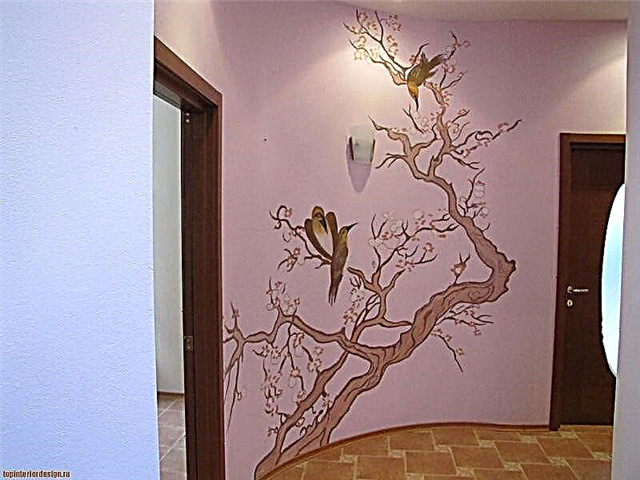
- Lightness - due to this, it is quite simple to mount it on any wall and, if necessary, replace it.
- Heat resistance - it easily tolerates temperature changes when it can crack like a natural stone.
- Choice - a variety of shapes, colors and textures, make it possible to create a unique hallway.
- Low cost - a decorative stone is several times cheaper than natural.
- Ease of maintenance - the walls are easy to clean, which is as important as the entrance hall is the fastest polluting room.
- Strength - has a high resistance to external physical influences.
- Environmental friendliness - a decorative stone does not contain harmful impurities in its composition.
- Resistance to ultraviolet - it does not change the shades of the original color, under the influence of sunlight.
Choosing a decorative stone for future repairs, you need to know what it is made on the basis of. Most often, to create an artificial stone, use:
- Cement. When creating such a tile, cement, sand, a variety of fillers, coloring pigments, plasticizers and reinforcing agents, such as pumice, ceramic chips or expanded clay, are used. Stone tile from it is not afraid of high humidity. It is heavier and more expensive, and additional tools will be required during its installation.
- Porcelain tile. It is made from several types of burnt clay, coloring pigments, minerals and feldspar. This type of artificial stone is more like a tile than a stone. It is very durable and does not absorb moisture at all.
- Gypsum. The tile resembles sandstone. Stone imitation of it is easier and cheaper, it is easy to do it yourself. The only drawback is the fear of water. But this is not scary if the tiles are additionally treated with acrylic varnish.
- Conglomerate. It is considered the most durable of all types, but somewhat more expensive. This tile is made of quartz sand, dyes and limestone chips, with the addition of marble and granite chips. No specialist will be able to distinguish this decorative stone from marble or granite.
- Liquid or acrylic stone. It is made from resistant polymers by pouring into molds, which allows you to create high-quality imitation, and at the same time lightens the material.
Types of decorative stone
Decorative stone is divided according to the decor of the front side:

- Brick - a tile that imitates various types of bricks and its masonry.
- Chipped - a tile resembling an unprocessed stone.
- Sawn - tile, looks like part of a sawn unpolished block.
- Butovy - a tile in the form of boulders or pebbles.
- Finishing tile is a tile imitating natural smooth stone.
- Fantasy stone is a tile, the components of which are nonexistent stones complex in texture and color.
Related video:Decorative stone trim for a modern apartment
Hallway decoration
As can be seen from all of the above, there are a lot of options for decorative stone and you can pick it up for every taste and budget, but the hallway is a special room, which is sometimes very difficult to decorate correctly, especially if it is small.

The complexity of stone wall decoration is that, despite the fact that it is an imitation or natural material, it creates a heavy oppressive feeling. That is why, before you start decorating the corridor, you need to carefully consider every nuance. The most important nuance can definitely be considered the choice of texture and color of the stone.

Nature does not tolerate uniformity, and even stones come in a variety of colors. If we talk about the hallway, then dark tones here are best avoided, especially if it is a stone. An oppressive sensation will remain in such a room, even if it is filled with bright light.
It concerns granite or marble of dark colors. These are stones that, by definition, are heavy, and not only in terms of their weight, but also in moral perception.K, too, they are rarely with a voluminous texture, which means that decorating the hallway with their help is very limited.

Their color scheme is very wide, from brown to bright yellow. And this allows you to combine several colors in the hallway, while using only one or two breeds, even if it's just an imitation.
Tip. choosing a decorative stone for the interior of the hallway, do not combine many rocks. Their maximum can be three, and then, if the room is medium in size.

Another important nuance that should be carefully studied. In nature, stone is most often found in the form of various boulders with an unexpressed texture, and only after a complex process of processing does it acquire the same, familiar shape and color. This is especially clearly seen on the example of granite, one of the varieties of which is ordinary building rubble, gray and nondescript. But after sawing into slabs and thorough grinding, it takes on a smooth shape with a bright color and a characteristic pattern.
Also, you can beautifully beat some pieces of furniture that can be found in the hallway. For example, you can create a small decorative apron above the key table, or a back near the couch.

As you know, light plays a key role in any design decision, and for stone decoration, it is no less important. The severity and monumentality of the stone elements is inherent even in artificial imitation, therefore, in places where such decoration is used, there should be more light.

Here you can use spotlights with a directional beam, or LED strip, which will complement the stone composition, giving it saturation.
Important. When decorating a hallway, you should always use several light sources, while maintaining the total number of watts over the entire area.
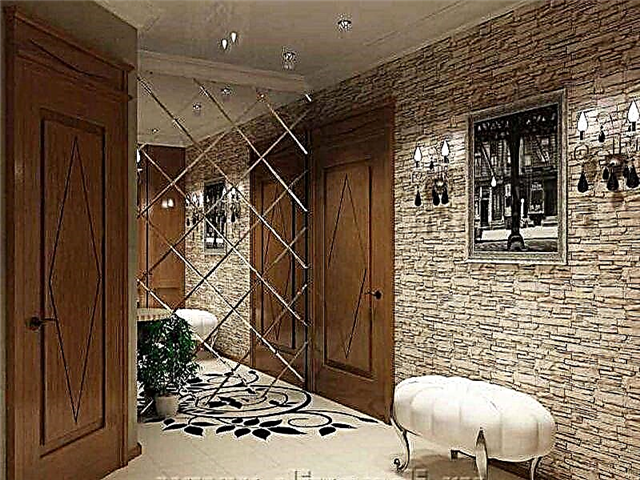
It is better to refuse experiments with different colors of LEDs in this case, the stone decor, in itself, is self-sufficient and it does not require additional nuances. In addition, the color of the lamps can dramatically change the perception of stone. And in the end, those who come to the house will have a feeling of tastelessly executed imitation.
Onyx finish
Of the decorative stones that can be used in home decoration, this is the most expensive, but from that the most effective material. Its key feature is transparency. Of course, completely finishing the walls with onyx will be very expensive and not practical, but small inserts or wall panels will look very impressive.
It is difficult to overestimate the advantages of this stone, but its overabundance can develop into a bad manners. In addition, it is unlikely to be able to independently establish such elements, and you can’t do without the help of specialists. You can certainly take a chance and try to do everything yourself, but is it worth it?
Artificial gypsum stone
Gypsum-based stone is considered the cheapest and lightest material of all. However, it is very brittle and hygroscopic, so if moisture gets on it, it can break down. That is why in the process of decorating the hallway, it is necessary to conduct surface treatment with a special varnish.
Cement based artificial stone
Cement-based finishing stone is heavier and more expensive, since high-quality cement is used in its production. Cement also needs time to obtain the required strength (about 28 days), and all this time the tiles must be stored in a warehouse, which causes additional costs.

However, this finish is durable and durable. The stone is allowed, even if it is washed with special detergents. Therefore, when decorating a hallway with a stone in an apartment, this material was most widely used.

Agglomerate Stone
This material has appeared recently. It contains fragmented granite, marble and quartzite. Cement or resin is added to the solution.In order to make this stone brighter, dyes are added.

Finishing the hallway with stone on your own
As a preliminary preparation, you need to determine the amount of necessary material. It is recommended to draw the borders of the finish on the wall and calculate the number of square meters, then add another 10-15% to this for possible changes in the course of work.


